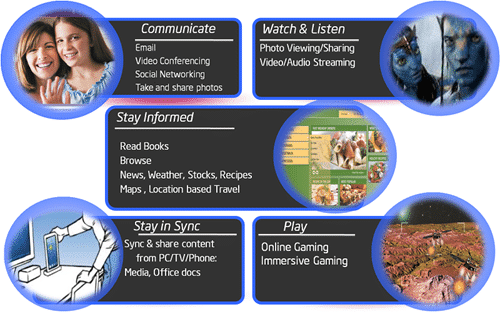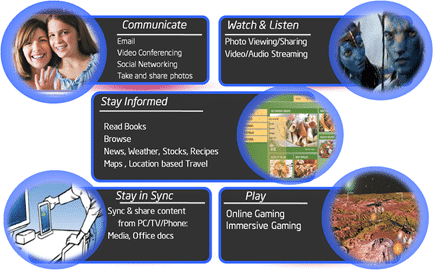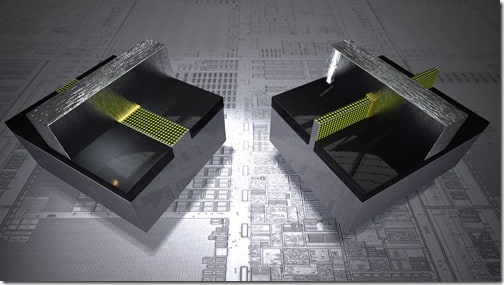Part of being an Intel Advisor is getting insights and information directly from inside Intel. This month’s conference call with Intel and other Intel Advisors was no different and we learned about a hot topic in the Tech industry – the tablet race. Leading our discussion was Mark Miller, director of outbound marketing from Intel’s Netbook and Tablet team. Not only did we learn Mark’s take on tablets and other mobility devices, but also he explained Intel’s vision to take ON tablets and these devices and move the space forward.
It was a candid discussion from the get-go. Intel’s mobility (netbook and tablet) group was recently formed in order to better define and shape the tablet and netbook marketplace. Miller admits that Intel is not yet where they want to be within the tablet marketplace, but he also clearly outlined their thoughts and directives to change this as well as provide insights as to how Intel will work to develop the next generation of mobility products.
Below are the usage categories of tablet-like devices that we currently enjoy, however Intel is looking to evolve this, as I outline further within this article:
(image source: Intel AppDeveloper)
Miller breaks down the “Mobility” category into 3 segments: Netbooks, Tablets and a new third category which they are simply calling a “Hybrid Device.”
Exploring the Categories
What’s below is obviously not an exhaustive discussion of these categories, as the specs, features, ideas and concepts are still being decided on and written. But the Advisor briefing definitely got the gears spinning.
Netbooks
There is a misperception that the netbook market is declining dramatically. In fact, Intel has found that the market is only off by 5% or so. 30 to 35 million units a year are being shipped and sold. However Miller does admit that tablets, specifically the Apple iPad, has taken away some of the appeal of the netbook. For Intel, they realize that the demand, if in different market segments, is still there and they realize that there will always be an appeal for a “low cost computing experience.” Miller pointed out that Intel hasn’t refreshed the silicon that is driving the netbook market and consequently may have contributed to its stagnant nature.
This is all about to change, however, as there still is demand, especially for an even lower price point…the magic number of $199 for a netbook targeted towards emerging markets, schools & education or even as a second PC. But users might not be waiting simply for a lower price, they want better performance from the CPU and more powerful graphics capabilities. To accomplish this, Intel will be introducing a new Atom processor, code named “Cedar Trail” which is expected to be released in the second half of 2011. Core to this updated netbook infrastructure will be the addition of more PC-like features like Wi-Di or PC sync. I saw Wi-Di (“Wireless Display”) in action at a couple of shows; it’s an impressive way to share multimedia content from a computer to a big screen TV. Simply start playing a movie, for example, on a Wi-Di enabled computer and then with an appropriately configured TV, your media starts streaming. It’s very similar to Apple’s AirPlay.
My take on this: I honestly thought that PC makers had squeezed what they could out of netbooks. I’m sure that the profit margin on these is extremely small. However, the thought of having to refactor or realign strategies or manufacturing to support a tablet could be cost prohibitive. So, if Intel will be producing a more powerful but similarly priced Atom processor to power a next generation of netbooks, the netbook market may still have some life left in it. I find that in my family, netbooks are pretty compelling for all of my kids who are students. With long battery life and the small form factor, they are ideal for elementary, middle and high school students. However, this also depends on what happens in the tablet as well as the 3rd category below (the “hybrid device”).
Tablets
Obviously, this category is where all of the focus and media attention is. It seems that the world views Apple as the clear leader in the space, already on their second generation tablet while others struggle to even release a first gen that is competitive from a features and pricing standpoint. In April of this year, Intel introduced a new Atom processor for tablets, code name “Oak Trail” which should start hitting tablets in May. Most of Intel’s efforts has been around Windows 7-based tablets but there are definitely efforts underway to handle other mobile OSes like Android.
As I mentioned previously, Miller acknowledges that Intel is a bit behind the game in the tablet race. However, they do seem to also have a differentiating vision, in my opinion. With Apple, it’s pretty much one size fits all, meaning the experience is focused more around the device and less around a particular user’s use case. I think that this is fine for Apple, as this is where they want to be, providing an elegant and easy to use, but controlled environment. Intel believes, however, that tablets should be as individual as you are, meaning that you should be able to customize and tailor a tablet to better fit a given user. With the iPad, IT is the center as opposed to the person using it being the center. This concept actually is even more appropriate for the 3rd category below.
Intel will be working to make the processor technology within tablets faster, while designing their chipsets to use less power and be smaller, thus allowing for thinner tablets. Some benchmarks outlined by Miller was getting below 8mm in thickness (e.g., “thinness”) and having 10 hours active battery life with 30 days of standby – pretty much a good standard. If they can pull this off running a mobility version of Windows 7, that would be impressive.
My take on this: I’m a bit worried about the focus on Windows 7 as the platform for these next generation tablets. Apple obviously has the user interface nailed down (however, I do think that even a refresh there is needed as I don’t feel that iOS on the iPad is a fully optimized experience). Android will be making good inroads and will have a series of first generation tablets that are tried and tested and will be improved upon. I’m not convinced that Windows 7 will be fully suitable for this uphill task. However, having Intel focus on creating better chips specifically design for this space is very important, part of the reason why Apple purchased a chip manufacturer to produce chips for their iPhone and iPads. If Intel can bake more performance for the CPU and video processing (just as they will for the next gen netbook), any tablets running this processor will be competitive.
“Hybrid Device”
This next category is really the intriguing one and represents a merging of the best features and technology available to netbooks and tablets. There are already devices like this in the market, in fact, Microsoft had supported this type of computer many years before the iPad even came out. We have seen swivel-display computer from Fujitsu, for example, that had a screen that pivots to cover a keyboard. This “hybrid” style is exactly something that Intel believes is worth investing in. Think about coupling a touch screen display (e.g., a tablet) with a keyboard (e.g., a clamshell or netbook) and you have this hybrid device. The Dell Inspiron Duo is a current example of this type of form-factor.
However, Miller believes that there is much more to be done with this form-factor and the underlying OS and software driving it. Without offering many details, he did say they will be ultra thin with low power consumption, which seems to be a common thread on all new consumer electronics devices coming out these days. But what was presented was the idea of this device really meeting multiple yet individual needs. For example, you could have it so that if when you are using the keyboard and are at work, you would use Windows 7 as the OS, but when you went home and move more to a tablet-appropriate environment, the OS might shift to Android. Also, as kids are growing up using these devices much the same way we used pen and paper, there could be appropriate “user environments” within this hybrid device to satisfy their needs.
My take on this: I do think that tablets still have some shortcomings for some situations. Yes, the iPad is penetrating the business place, but there is still a need to provide more power that is less consumer focused and more business-centric than the current devices. The Blackberry PlayBook actually tried to do this by forcing users to have a Blackberry device in order to get the full capabilities of the tablet (e.g., a mail client). I don’t think that Blackberry took the right approach on this personally, by forcing users to do it one way. I better like what Intel is proposing, giving the user the option to configure their environment the way that is most appropriate to how they will interact and engage with it. But time will tell if this multi-OS, multi-form-factor, multi-use case device can be perfectly pulled off.
So What’s Next?
12 to 18 months ago, tablets didn’t exist (although there are plenty of people who will disagree with this statement). So, to qualify that a bit more, I would say the modern, consumer-friendly tablet didn’t exist. In another 12-18 months, the tablets (like the iPad) that we know and love currently will be long gone and replaced with devices that are more powerful, thinner, multi-function with batteries that last 20 hours of active use, and capable of powering full entertainment systems and replace computers. Well, I could be dreaming a bit.
Oh, and one more thing…yesterday, Intel introduced a new design to their transistor chip. Called “Tri-Gate,” this revolutionary 3-D design clearly shows Intel’s innovation at work. While the concept of this design has been discussed for several years, Intel is the first manufacturer to move this design into production. It provides not only performance improvements, but also allows for power reduction within 22nm-based devices that include the categories mentioned above.
(image source: Intel Press Room)
Above you can see an illustration of the 32nm transistor (on the left) compared to the new 22nm (on the right). The yellow dots represent how the current flows. The 32nm illustrates current flowing along a plane while the 22nm shows it flowing on 3 sides of a vertical fin.
But back to the tablet race, Apple seems to have the lead…for now. But as companies regroup and look to improve, I’m expecting some pretty innovative products coming out. I think with Intel working to drive the innovation from within, providing more powerful and smaller chipsets to power these emerging tablets, we are just beginning to see a really exciting market develop and emerge.
Disclosure: I am part of the “Intel Advisor” program and am compensated and/or receive other value from Intel to attend events on their behalf. My opinions about Intel and my writing are entirely my own and not those of Intel, nor subject to their editorial approval. More information can be found in my About page as well as here.
HTD says: For me, it was really exciting to not only get Intel’s take on these types of devices, but also to see how they are planning on taking on the market with some new innovations within this exploding space.




